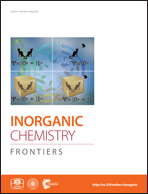Metal–organic aerogels based on dinuclear rhodium paddle-wheel units: design, synthesis and catalysis†
Abstract
A series of metal–organic gels (MOG-Rh-1a–d) are synthesized by the reaction of dirhodium(II) tetraacetate (Rh2(OAc)4) and the tricarboxylic acid 4,4′,4′′-[1,3,5-benzenetriyltris(carbonylimino)]tristribenzoic acid (H3btctb) in DMF/water or DMF/methanol. After drying with subcritical carbon dioxide, metal–organic aerogels (MOA-Rh-1a–d) were obtained and fully characterized by EA, SEM, TEM, TGA, PXRD, UV-vis, XPS and EXAFS measurements. The presence of dinuclear rhodium paddle-wheel units and the Rh2+ valence in the aerogels are proven by UV-vis, XAS and XPS spectra. As revealed by the SEM and TEM images, the aerogels have a general porous structure with an entangled worm-like morphology. The porosity of the aerogels is confirmed by nitrogen adsorption at 77 K, and the sorption isotherms present type-IV curves, indicating that both micro- and meso-porosities are present. The accessibility of the mesopores is verified by dye uptake such as methylene blue (MB, 14.4 × 6.1 Å2) and Coomassie brilliant blue R-250 (BBR-250, 22 × 18 Å2). The catalytic tests disclose that MOA-Rh-1d is effective in the coupling reaction of CO2 and epoxides as well as intramolecular C–H amination of vinyl azides. MOA-Rh-1d can be recycled easily and used for at least ten runs with yields in the range of 91–98% in CO2 conversion reactions.

- This article is part of the themed collection: Sino-European Collaborators


 Please wait while we load your content...
Please wait while we load your content...